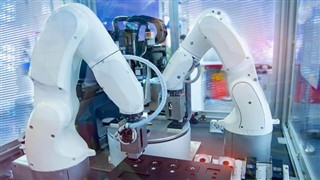SSZT129 October 2021 LM25184 , LMG3422R030
It’s no secret that industrial and collaborative robots require high power density with excellent thermal performance. Because robotic systems are moving from a centralized to a decentralized architecture, they require very efficient and small integrated circuits so that a motor drive will fit inside the robot arm.
Integrated motor drives save space, since the drive and motor are housed as one unit. Plus, integration eliminates the need for expensive, long cables from the robot cabinet to the manipulator connecting the motor and drive.

Cables are not just expensive; they require periodic maintenance, especially in multiaxis systems where robots move continuously. Cabling issues also necessitate troubleshooting, which can be time-consuming and lead to a loss in productivity. Integrating the drive with the motor reduces the number of cables while also saving space.
Although there are multiple benefits for integrating the drive with the motors, there is one major challenge with the thermal design – the drive components are exposed to higher ambient temperatures with limited cooling, making it more difficult to deliver the rated power at those temperatures. This condition puts a stringent limit on the losses in the drive inverter and thus requires a high-efficiency drive.
| Explore the benefits of increasing power density in your factory automation designs | |

|
Read our white paper to learn how we are addressing factory automation challenges with innovations in power design. |
Two types of drives can help meet the challenges I’ve described. The first option is to use conventional insulated gate-bipolar transistor (IGBT)-based inverter drives, although they cannot be integrated easily with the motor given the high losses in the IGBTs caused by reverse recovery in the diode. Switching losses mean that you’ll need a larger heat sink or liquid cooling, which will not allow integration with the motor.
The second (and better) option is to use gallium nitride (GaN) field-effect transistors (FETs). TI’s family of GaN FETs with integrated gate drivers and GaN power devices offer an efficient solution with lifetime reliability and cost advantages. GaN transistors can switch much faster than silicon metal-oxide semiconductor field-effect transistors (MOSFETs), offering the potential to achieve lower switching losses that result in less heat dissipation. GaN transistors also reduce system cost and size for elements such as heat sinks, fans, and their assemblies, especially when space is limited (like in a robot arm).
Adding a GaN power device can present integration challenges; however, you can simplify the task by choosing a product that combines a GaN FET with an integrated silicon gate driver and protection features. The LMG3422R030 is one example. Designed for high-density industrial power supplies used in industrial robot and motor drive systems, the LMG3422R030 includes features such as adjustable gate-drive strength for electromagnetic interference (EMI) control, and overtemperature and overcurrent protection with fault indication.
Robot controllers also include a flexible number of analog input/output modules with isolated power and signal paths. As channel counts increase and packages get smaller, existing isolated switching topologies need to improve.
Adding synchronous rectification can extract greater efficiency even from time-honored designs such as the flyback regulator. Efficiencies well in excess of 90% are possible, but synchronous rectification adds complexity and cost to the classic flyback design, as it typically requires a synchronous rectifier controller on the secondary side of the transformer and optocoupler feedback to the primary-side flyback controller.
In such cases, a flyback converter such as the LM25184 may be the answer: It uses primary-side regulation and does not require an optocoupler or auxiliary transformer winding to provide feedback. The LM25184 can achieve 90% efficiency over a wide load range and is available in a 4-mm-by-4-mm thermally enhanced very thin small-outline no-lead package. The maximum input voltage of 42 V provides ample headroom to accommodate transients on a standard 24-V industrial bus.
Taking power-supply considerations into factory automation application design is a complex task. Depending on the application, the products need to successfully operate in busy factory environments, fit into the available space, comply with EMI requirements, and provide protection for humans and machines alike.